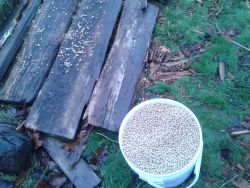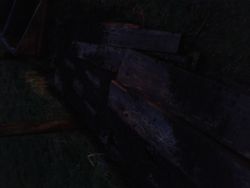Halifax Media Co-op
News from Nova Scotia's Grassroots
Hugul Helper: building our own soil
In 2006 I watched the films The End of Suburbia and An Inconvenient Truth in the same year. For the rest of that year my head exploded and I questioned everything about our lifestyle and began a prepper phase that included buying a lot of dry goods. I learned some things like flour kept well for a couple of years, and that others like soy go moldy quickly. I also later learned that a good way to hold onto large batches of dry goods is to keep them in a sealed mylar container with oxygen-consuming hand-warmers to create a low-oxygen environment, but that is a topic for another blog post. The important part was that I had to dispose of 10 kg of musty soybeans that had sat in my basement for 9 years.
![]()
It was like a cement SUV backed up into the cul-de-sac of my life and then ran out of gas
Flashing forward to this year, my community garden, Hilda Unity Garden Society, redid their raised beds and had a lot of rotten, moldy, punky mushroomy lumber to dispose of. We are also going to have to get in the habit of creating our own soil because we won't be able to import truckloads of it once the EAC grant runs out. Good compost contains a source of nitrogen (such as soybeans) and carbon (like spoiled lumber) Suddenly I had a disposal plan.
The hugels were made up of a layer of lumber, a sprinkle of soybeans, and covered with some soil to inoculate the logs, fill any cracks to help prevent any cozy hidey-holes for mice or other rodents, and keep the whole assembly damp to rot faster. I had completed one hugel before the darkness fell and the heavens opened up with a deluge of cold November rain. Excellent.
Hugelkultur beds were a traditional practice in Germany and Austria before being popularized by Sepp Holtzer in the 1970s. Mature forests exhibit a pit-and-mound structured forest floor, made up in part by the root stumps of fallen trees that rot in place. This increases the soil's surface area, creating more space fo plants (and animals) to live and creates hotter, drier and cooler and wetter micro-climates.
The rotted wood creates insect habitat and holds water like a sponge. It releases plant nutrients slowly and the decay even generates some warmth. Finally the wood decomposed under soil and away from some of the atmosphere's oxygen sequesters carbon into the soil where it can stay for a very long time. Hugelkultures can be used to orient beds for greater southern sun exposure, and create more space in a small plot of land.
More information can be found here:
The site for the Halifax local of The Media Co-op has been archived and will no longer be updated. Please visit the main Media Co-op website to learn more about the organization.




